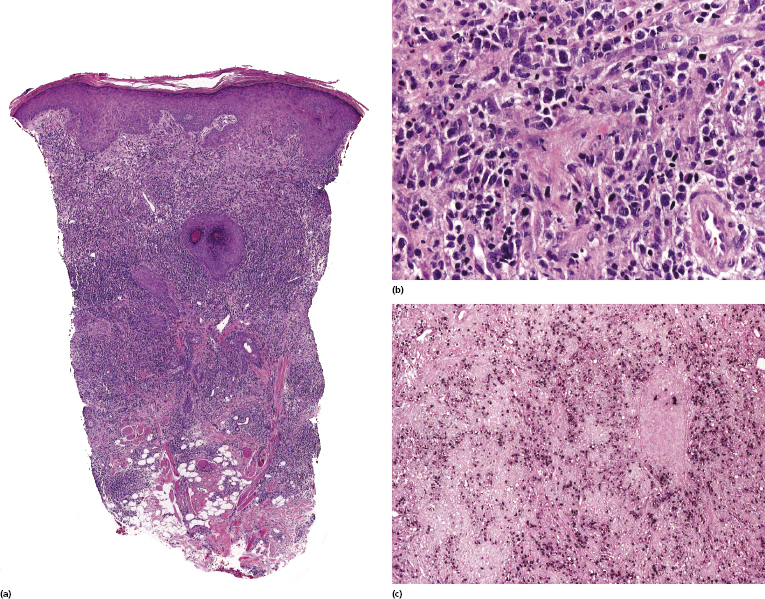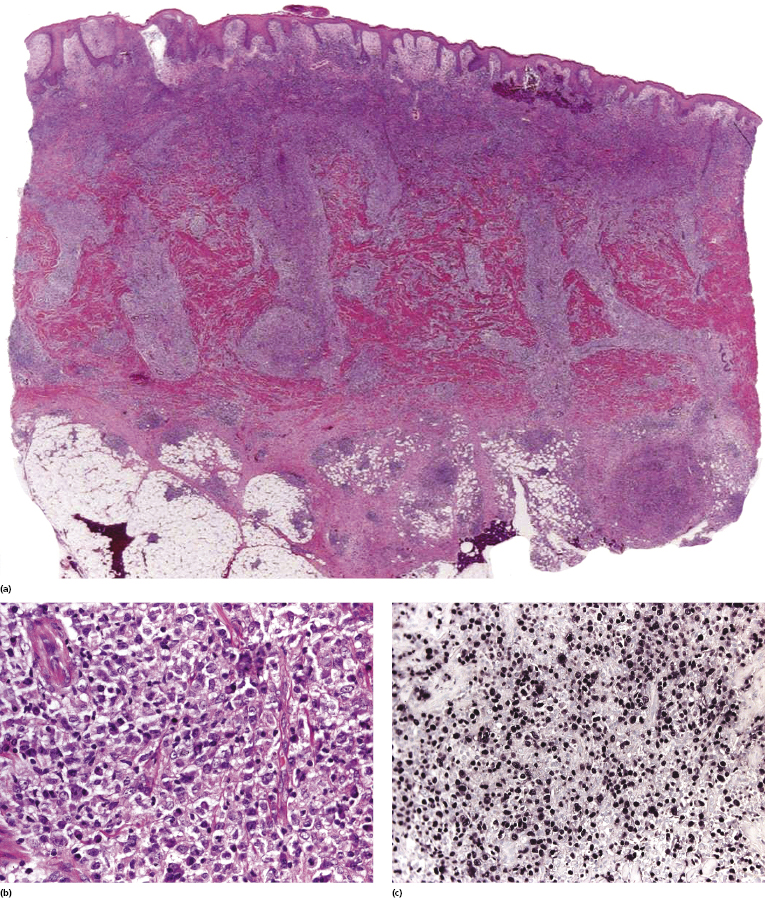Cutaneous Lymphoproliferative Disorders in Other Iatrogenic and Non-Iatrogenic Immune Deficiencies
Besides post-transplant and human immunodeficiency virus (HIV)-related lymphomas, cutaneous lymphoproliferative disorders may occur in any other iatrogenic or non-iatrogenic immunodeficiency, including congenital immune deficiencies and iatrogenic immune deficiencies related to the use of methotrexate or other immunosuppressive or immunomodulatory drugs. These lymphomas are included in two chapters in the World Health Organization (WHO) Classification of Tumours of Hematopoietic and Lymphoid Tissues [1, 2].
The development of lymphomas in patients under methotrexate therapy is well known [3, 4]. In recent years, the onset of cutaneous or extracutaneous lymphomas has been described also in patients undergoing treatment with immunosuppressive or immunomodulatory drugs (“biologics”) [5–10]. In some of these cases, a wrong diagnosis of atopic dermatitis or psoriasis had been made and treatment with one of the many immunologic agents had been started, resulting in rapid progression of an undiagnosed mycosis fungoides (see also Chapter 2) [7–9]. These particular cases have been termed “monoclonal antibody immunomodulator-related lymphoid proliferations” [10]. The lymphomas occurring in these settings have clinicopathologic features similar to corresponding entities observed in patients who do not take the drug, the main difference being represented by a higher rate of association with Epstein–Barr virus (EBV) infection. In some cases, rapid histopathologic progression from early changes to fully developed lesions has been documented [11]. In over half of the cases associated with methotrexate treatment, the lesions regress upon withdrawal of methotrexate.
Besides iatrogenic-induced or infection-related immunosuppression, cutaneous lymphomas may arise in the setting of congenital immunodeficiency disorders such as Wiskott–Aldrich syndrome or ataxia–telangiectasia, among many others [1, 12]. The most frequent lymphoma type observed in this group of patients is diffuse large B-cell lymphoma, and clinicopathologic features are similar to those observed in immunocompetent hosts. Lymphomatoid granulomatosis is also found at a higher frequency. The incidence of different types of lymphomas is different in the various types of congenital immunodeficiency disorders.
Clinical Features
Clinical features are not different from those of the corresponding cutaneous lymphomas arising in immunocompetent patients. Immunosuppression-associated mycosis fungoides shows a more rapid progression of lesions from patches to plaques and tumors than in conventional cases, underlining the role of the immune system in the long-term control of the disease.
Histopathology, Immunophenotype, and Molecular Genetics
Histopathologic features are similar to the corresponding entities in immunocompetent individuals. There is a higher frequency of EBV infection, even in cases that are usually not associated with the virus (e.g., cutaneous anaplastic large cell lymphoma), a situation similar to that observed in HIV-related and post-transplant cutaneous lymphomas.
Besides conventional entities of cutaneous lymphoma, some patients may show lesions similar to those observed in post-transplant cutaneous lymphoproliferative disorders, with both polymorphic (Fig. 18.1) and monomorphic aspects (Fig. 18.2) (see also Chapter 16).


As in other cutaneous lymphomas associated with immune suppression, in some cases precise classification may be difficult and overlapping features of different lymphoma types may be present [13]. An angiocentric pattern with angiodestruction and prominent necrosis has been observed in two cases of methotrexate-related cutaneous diffuse large B-cell lymphoma, suggestive of lymphomatoid granulomatosis [14, 15]. Both cases were positive for CD30, but EBV was detected within tumor cells in one of the two cases only.
It should be remembered that knowledge of treatment with methotrexate or other immunosuppressive agents is an exclusion criterion for EBV+ diffuse large B-cell lymphoma of the elderly, which represents a frequent differential diagnosis of EBV+ cases with a B-cell phenotype.
Treatment and Prognosis
As already mentioned, in over half of the cases of methotrexate-associated cutaneous lymphoma the lesions regress upon withdrawal of methotrexate. Regression upon discontinuation of treatment may be observed also in cases associated with the use of cyclosporine and systemic steroids [16]. In patients with congenital immune deficiencies the treatment must be aimed at both the background condition and the lymphoma, depending also on the lymphoma type.
Similar to what was described in HIV-related cases, an aggressive course has been observed in cutaneous anaplastic large cell lymphoma related to other types of immune deficiency as well [17], suggesting that in immunosuppressed individuals this lymphoma may have a worse prognosis irrespective of the cause of the immune deficiency.

Full access? Get Clinical Tree


